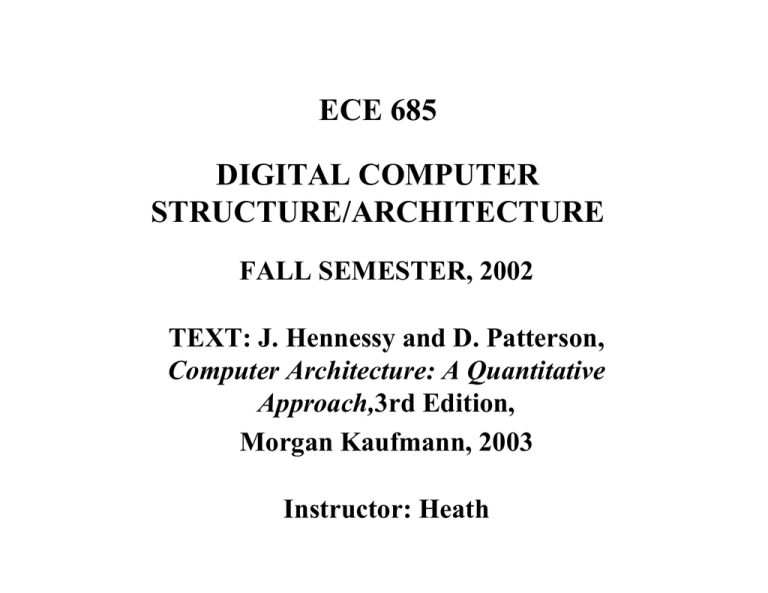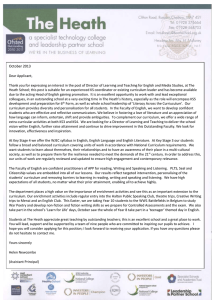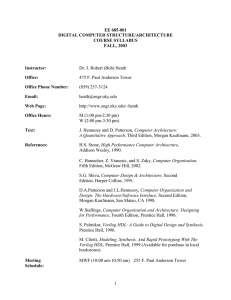ECE 685 DIGITAL COMPUTER STRUCTURE/ARCHITECTURE FALL SEMESTER, 2002
advertisement

ECE 685
DIGITAL COMPUTER
STRUCTURE/ARCHITECTURE
FALL SEMESTER, 2002
TEXT: J. Hennessy and D. Patterson,
Computer Architecture: A Quantitative
Approach,3rd Edition,
Morgan Kaufmann, 2003
Instructor: Heath
SYLLABUS
ECE 685-001
DIGITAL COMPUTER STRUCTURE/ARCHITECTURE
COURSE SYLLABUS
FALL, 2002
•
•
•
•
•
•
Instructor:
Office:
Office Phone Number:
Email:
Web Page:
Office Hours:
Dr. J. Robert (Bob) Heath
313 Electrical Engineering Annex
(859) 257-3124
heath@engr.uky.edu
http://www.engr.uky.edu/~heath
M (3:30 pm-5:00 pm)
W (2:30 pm-4:00 pm)
•
Text:
J. Hennessy and D. Patterson, Computer Architecture:
A Quantitative Approach, Third Edition, Morgan Kaufmann,
2003.
•
References:
H.S. Stone, High Performance Computer Architecture,
Addison Wesley, 1990.
C. Hamacher, Z. Vranesic, and S. Zaky, Computer Organization,
Fifth Edition, McGraw Hill, 2002.
S.G. Shiva, Computer Design & Architecture, Second
Edition, Harper Collins, 1991.
D.A.Patterson and J.L.Hennessy, Computer Organization and
Design: The Hardware/Software Interface, Second Edition,
Morgan Kaufmann, San Mateo, CA 1998.
Heath
2
SYLLABUS (continued)
•
W.Stallings, Computer Organization and Architecture:
Designing for Performance, Fourth Edition, Prentice Hall, 1996.
•
S. Palnitkar, Verilog HDL: A Guide to Digital Design and
Synthesis, Prentice Hall, 1996.
•
M. Ciletti, Modeling, Synthesis, And Rapid Prototyping With
The Verilog HDL, Prentice Hall, 1999 (Available for purchase
in local bookstores).
MWF (10:00 am-10:50 am) 303 Slone Research Bldg.
•
Meeting Schedule
•
Course Description
Study of fundamental concepts in digital computer
system architecture/structure and design. Topics include: computer system modeling based on
instruction set architecture models; architecture and design of datapaths, control units,
processors, memory systems hierarchy, and input/output systems. Special topics include
floating-point arithmetic, multiple level cache design, pipeline design techniques, multiple
issue processors, and an introduction to parallel computer architectures. Use of Hardware
Description Languages (HDLs) for architecture/design verification/validation via presynthesis simulation. Prereq: EE380 and EE581 or consent of instructor.
Heath
3
SYLLABUS (Continued)
•
Topical Outline
•
Grade:
1. Introduction to Computer Architecture and Design Fundamentals.
2. Instruction Set Architecture Models.
3. Introduction to Computer Architecture/Design Verification via use of
a Hardware Description Language (HDL) – VERILOG.
4. Instruction Set Principles and Examples.
5. Pipelining.
6. Advanced Pipelining and Instruction-Level Parallelism.
7. Memory Hierarchy Design.
8. Storage Systems.
9. Input/Output Systems.
10. Computer Design & Design Documentation and Verification via
VERILOG.
11. Interconnection Networks.
12. Introduction to Multiprocessors and Models.
13. Introduction to Vector Processors.
Test 1:
(October 11)
25%
Test 2:
(November 25)
25%
Homework: Design, Design Verification Projects:
25%
Final Exam -Comprehensive (Fri. Dec. 20 (10:30 am)):
25%
Your final grade will generally be determined by the number of points you have accumulated from 100 possible points
as follows:
A:
90-100 pts.
B:
80-89 pts.
C:
70-79 pts.
E:
69 or below
An equitable grade scale will be applied when warranted.
Heath
4
SYLLABUS (Continued)
•
Make-Up Examinations
Make-up examinations will only be given to students who miss
examinations as a result of excused absences according to applicable
university policy. Make-up exams may be of a different format from the
regular exam format (Example: Oral format).
•
Cheating:
Cheating will not be allowed or tolerated. Anyone who cheats will be
dealt with according to applicable university policy. (Assignment of a
grade of E for the course).
•
Class Attendance
Attendance of all class lectures is required to assure maximum course
performance. You are responsible for all business conducted within a
class.
•
Homework Assignments
Homework assignments will be periodically made. All assignments may
not be graded. Assignments are due at the beginning of the class period on
due dates.
Heath
5
VERILOG
• A Hardware Description Language (HDL) Used To Describe
Digital Systems Hardware Design and Structure.
• A HDL Can Be Used For Digital System Design
Verification/Validation and ImplementationVia HDL
Simulation, Synthesis, And Implementation.
• Systems May Be Described At Three Levels: Behavioral,
Register Transfer (Dataflow, Equation), And Gate (Structural)
Levels.
• Example:
• Binary Full Adder
Heath
6
Verilog Coding Example: Binary Full Adder (bfa)
Gate (Structural) Level Coding Style
module fulladd1 (I2, I1, I0, so, co); // Module Name and Input/Output Signal
//Declaration
input I2, I1, I0 ;
// Input, Output, and Wire Declaration
output so;
output co;
wire wx0, wa0, wa1, wa2;
xor XO (wx0, I2, I1);
// Gate Identification, Instantiation Names, an Output/Input(s)
xor X1 (so, wx0, I0);
and A0 (wa0, I1, I0);
and A1 (wa1, I2, I1);
and A2 (wa2, I2, I0);
or (co, wa0, wa1, wa2);
endmodule
// End of Module
// “and AI #2(wf,wc,wd)” Gate Delay Of 2 Simulation Time Units.
Heath
7
Verilog Coding Example: Binary Full Adder (bfa)
Register-Transfer-Level (RTL), Dataflow, Or
Equation Level Coding Style
// "bfa" RTL Coding Style.
module fulladd2 (I2, I1, I0, so, co); // Module Name and Input/Output Signal Declaration.
input I2, I1, I0 ;
output so;
output co;
// Input, Output, and Wire Declaration.
assign so = I2 ^ I1 ^ I0;
// Equations of Binary Full Adder (bfa). Bit Wise Exclusive-OR (^).
assign co = (I2 && I0) || (I1 && I0) || (I2 && I1); //Logical AND (&&); Logical OR (||).
//Bit Wise AND (&); Bit Wise OR (|).
endmodule
// End of Module.
Heath
8
Verilog Coding Example: Binary Full Adder (bfa)
Behavioral Level Coding Style
// "bfa" Behavioral Coding Style.
module fulladd3 (I2, I1, I0, so, co); // Module Name and Input/Output Signal Declaration.
input I2, I1, I0 ;
output co, so;
reg co, so;
// Input and Output Declaration.
// Port (Signal) Values Are Held Until They Change.
always @ (I2 or I1 or I0)
//Following Code Executed Anytime I2, I1 or I0 Changes
begin
//Value.
case ({I2,I1,I0})
//Use Behavioral Level "Case" Structure.
3'b000: begin co=1’b0; so=1’b0; end //Implements Truth Table..
3'b001: begin co=1’b0; so=1’b1; end
3'b010: begin co=1’b0; so=1’b1; end //3'b010 Implies 3-Bits Binary And They are
//010.
3'b011: begin co=1’b1; so=1’b0; end
3'b100: begin co=1’b0; so=1’b1; end
3'b101: begin co=1’b1; so=1’b0; end
3'b110: begin co=1’b1; so=1’b0; end
3'b111: begin co=1’b1; so=1’b1; end
endcase
end
endmodule
Heath
9
AUTOMATED TESTBENCH FOR “fulladd1” MODULE
module testfulladd1;
reg I2, I1, I0, Cot, Sot, flag; // Signals Declared to be Registers (Hold Values Until Changed)
wire Sos,Cos;
fulladd1 ADD0(I2, I1, I0, Sos, Cos); // Instantation of Module Under Test (MUT)
initial
begin
// This Process Defines Signals We Want to View as
// System is Simulated and the Code We Represent
// Signals in. Choices are Binary, Octal, or Hex
$monitor($time, "I2=%b I1=%b I0=%b Cos=%b Cot=%b Sos=%b Sot=%b flag=%b",
I2,I1,I0,Cos,Cot,Sos,Sot,flag);
end
initial
// This Process Generates Stimulus Inputs to MUT
begin: I2_loop
// and for Each a Theoretically Correct Output
integer m;
for (m = 0 ; m < 2; m=m+1)
begin: I1_loop
integer n;
for (n = 0 ; n < 2; n=n+1)
begin: I0_loop
integer o;
for (o = 0 ; o <2; o=o+1)
begin
#1
I2 = m; I1 = n; I0 = o; // Stimulus Applied to MUT Inputs
Heath
10
AUTOMATED TESTBENCH FOR “fulladd1” MODULE (Continued)
if(m == 0 && n == 0 && o == 0)
if(m == 0 && n == 0 && o == 0)
if(m == 0 && n == 0 && o == 1)
if(m == 0 && n == 0 && o == 1)
if(m == 0 && n == 1 && o == 0)
if(m == 0 && n == 1 && o == 0)
if(m == 0 && n == 1 && o == 1)
if(m == 0 && n == 1 && o == 1)
if(m == 1 && n == 0 && o == 0)
if(m == 1 && n == 0 && o == 0)
if(m == 1 && n == 0 && o == 1)
if(m == 1 && n == 0 && o == 1)
if(m == 1 && n == 1 && o == 0)
if(m == 1 && n == 1 && o == 0)
if(m == 1 && n == 1 && o == 1)
if(m == 1 && n == 1 && o == 1)
#1
Cot = 0; // Generation of
Sot = 0; //Theoretically
Cot = 0; //Correct Outputs
Sot = 1;
Cot = 0;
Sot = 1;
Cot = 1;
Sot = 0;
Cot = 0;
Sot = 1;
Cot = 1;
Sot = 0;
Cot = 1;
Sot = 0;
Cot = 1;
Sot = 1;
if((Cos==Cot)&&(Sos==Sot)) flag = 0; // Comparison of Theoretically
else flag = 1;
// Correct Output to MUT Output.
end
// “==“ Logical Equality
end
end
#5 flag = 1;
end
initial
begin
#150 $finish;
end
// Process Which Will Shut Down a Run-Away Simulation
// ie, Getting in an Endless Loop.
endmodule
Heath
11
SIMUCAD SILOS III DEMONSTRATIONS
(Use Files “bfa_gate_level” And “testbfa_gate_level”)
(Use Files “mux4x1_gate_level” And “testmux4x1_gate_level”)
•
Examples Of “Exhaustive Automated” Testbenches
Heath
12
CHAP. 1 –Fundamentals of Computer Design
•
•
Electronic Computing Originated in 1945.
Performance Growth
1945
? % Per Year
Technology and Architectural Innovation.
1970
25% – 35% Per Year
Technology Only.
1980
50% Per Year
*RISC – Technology and Arch. Innovation (Inst.
Level Parallelism (ILP) and Cache Memories.
* (Microprocessor Driven) Fewer: Mainframes
Supercomputers
1995
50% Per Year
*Technology and Architectural Innovation.
(Super Scalar Pipelining, ILP, and Parallel Processing)
*Application Classes: PCs, Servers, Embedded
Computers.
2002
Heath
13
Growth In Microprocessor Performance Due to Technology and Architectural Innovation
1600
1500
1400
1300
1200
1100
1000
900
800
700
600
500
400
300
200
100
0
Heath
14
TASK OF A COMPUTER DESIGNER (ARCHITECT)
1.
Determine Important Requirements/Attributes of a New Computer to be Developed.
2.
Design to Meet Requirements/Attributes and to Maximize Performance (When Required) and Lower
Cost.
•
Design Steps:
•
Computer Architecture:
Includes: 1. Instruction Set Architecture Design.
2. Functional Organization/Design.
3. HDL Design Capture/Verification via HDL Simulation and Experimental Prototype
Development and Testing.
4. Final Hardware Implementation and Testing.
1. Assembly Language Instruction Set Design.
2. Functional Organization (1. and 2. Comprise ISA Design).
3. Logic Design of Functional Units to RTL and Gate Level only when
Required.
4. Design Capture (Verilog or VHDL).
5. Organization/Architecture/Design Verification/Validation via HDL
Simulation.
6. Implementation.
* IC Design, Layout, etc.
* Power
* Cooling
* Low Power Design
* Testing
Heath
15
CURRENT COMPUTING MARKETS AND CHARACTERISTICS
Heath
16
FUNCTIONAL REQUIREMENTS FACED BY ARCHITECTS
(Architect Minimizes Cost and Optimizes Performance of Machine That Meets these Requirements)
Heath
17
TECHNOLOGY AND COMPUTER USAGE TRENDS
(IMPACTS ARCHITECTS WORK)
1.
2.
•
An Instruction Set Architecture Must Survive Changes In:
Hardware/Software Technology.
Changes In Applications.
Trends In Computer Usage
1.
An Increasing Amount of Memory Used by Programs (> 1.5 To 2/Yr.).
•
Implications on Address Bits. (1/2 To 1 Bit/Yr.).
2.
Less Use of Assembly Language. Compiler Writers Work Closely With Architects.
Trends In Implementation Technology
(Computer Designers Must Have An Awareness)
1.
•
Integrated Circuit Logic Technology.
55%/Yr. Growth Rate in Transistor Count/Chip.
•
Due To: Transistor Density Increase – 35%/Yr.
Quadruples in Approximately 4 Yrs.
Die Size Increase – 10% - 20% Yr.
Heath
18
2.
•
•
3.
•
•
Semiconductor DRAM.
40% - 60% Increase in Density/Yr.
* Quadruple In 3 - 4 Years.
Slow Improvement in Cycle Time.
* Decrease of 1/3 In 10 Years.
Magnetic Disk Technology.
Disk Density Improvement of 100% / Yr. (Unbelievable!!!)
* Quadruple In 2 Years.
Access Time Reduced by 1/3 In 10 Yrs.
RAID ?????
4.
•
•
•
•
LATER !!!!
Network Technology and Performance
Based on Performance of Switches and Transmission System (Latency
and Bandwidth are Main Parameters). Bandwidth is Current focus.
10Mb to 100Mb Ethernet Technology took 10 Yrs.
100Mb to 1Gb in 5 Yrs.
Internet Doubles In Bandwidth Every Year.
Heath
19
Wa
5.
•
•
•
•
Integrated Circuits
Feature Size of 10 Microns in 1971 – 0.18 Microns in 2001.
Transistor Performance Increases Linearly With Decreasing Feature Size.
Power Is Challenge!! Energy Per Transistor is Proportional to Product of Load Capacitance (Worse for
Smaller Transistors), Frequency of Switching, and Square of Voltage.
Intel 4001 Microprocessor Consumed Less Than A Watt - Pentium 4 (2 GHz) Consumes Almost 100
Watts – Server Processors Can Consume 150 Watts.
Heath
20
COSTS AND TRENDS
3 PHILOSOPHIES:
1.
High Performance at Any Cost!
Supercomputers. (Diminishing Market)
2.
3.
Use Technology, New Architectures to Achieve Lower Cost, Higher Performance.
Increasing Market, Most Challenging! General Purpose and Special Purpose Processors. (Text Focus.)
Low Price at Any Cost to Performance.
(PC Clones, Some Embedded Processor Applications!)
Learning Curve!!! (What is It??)
•
Principle That Drives Cost Down!
* Manufacturing Cost Decrease Over Time Due to Change In “YIELD”.
* EFFECT: Cost Per Megabyte of DRAM Drops Approximately 40%/Yr.
Lets Take a Look!!
Heath
21
LEARNING CURVE EFFECT
80
70
60
50
40
30
20
10
0
Heath
22
COST FACTORS OTHER THAN LEARNING CURVE
1.
2.
Volume- Reduces Learning Curve Time.
Commodities- Products Sold By Multiple Vendors In Large Volumes (Printers, RAM
Memory, Scanners, etc.
COMPUTER COSTS ARE PROPORTIONAL TO IC COSTS!!
•
IC Process:
Silicon Ingot is Cut to Wafers. “Wafer” Is Tested and Chopped Into “Dies”
That are Packaged.
Cost of IC = Cost of Die + Cost of Testing Die + Cost of Packaging and Final Test
Final Test Yield
Where:
And:
Sq. Peg In Round Hole
Cost of Die = Cost of Wafer
Dies Per Wafer x Die Yield
Dies per Wafer = ∏ x (Wafer Diameter/2)2 - ∏ x Wafer Diameter
Die Area
√(2 x Die Area)
Heath
23
Finally:
Die Yield = Wafer Yield x (1 + Defects per Unit Area x Die Area)-α
α
DISTRIBUTION OF COSTS IN A SYSTEM
Heath
24
•
How Can a Computer Architect Help Reduce Computer System Costs??
Reduce Die Area!
*Cost of Die = f ( Die Area 4)
COST VS PRICE:
Heath
25
COMPUTER PERFORMANCE
(MEASUREMENT/REPORTING)
•
Computer Performance is Based on the Time (Execution Time, Response Time) it Takes a Computer to
Execute “Real Programs”.
•
Computer X is “n” Times Faster Than Computer Y If:
Performance X
ExecutionTime Y
n=
=
Performance Y
ExecutionTime X
1/Performance Y
=
1/ Performance X
Heath
26
COMPUTER PERFORMACE (continued)
•
CPU time
•
UNIX Time Command Can Acquire Above Information for Program Runs;
=
CPU time (user) + CPU time (OS in Supporting User Program)
CPU Time (User).
•
90.7s
System CPU Time.
12.9s
2:39
Elapsed Time
65%
Percentage of Elapsed Time That Is CPU Time.
Heath
27
PERFORMANCE EVALUATION PROGRAMS (Benchmarks)
Best => To => Inadequate
•
Real Applications (Best!!!)
•
Benchmark Suites – Collections of Standardized Benchmark Programs Used to Measure
Performance of Different Application Classes. Most popular – SPEC (Standard Performance
Evaluation Corporation) Benchmark Set. www.spec.org
•
Modified/Scripted Applications
•
Kernels (Livermore Loops, Linpack, etc.)
•
Toy Benchmarks (10 to 100 Lines of Code – Puzzle, Quicksort, etc.)
Worthless in Measuring Performance.
•
Synthetic Benchmarks Similar to Kernals - Try to Match Average Frequency of
Operations and Operands of a Large Set of Programs. Not Real Programs.
Some Computer Companies Spend Large Amounts of Time/Money Optimizing Their
Computers (Hardware and Software) To Execute Benchmark Programs In Minimum
Time.
Heath
28
BENCHMARKS FOR THREE PROCESSOR CLASSES
Desktop Benchmarks
•
1.
Two Classes:
CPU Intensive
2.
Graphics Intensive
•
•
•
•
•
(SPEC CPU 2000 – 11 Integer Programs and 14 FP
Programs) - See Next Slide.
(SPECviewperf - www.spec.org )
(Others: Pro/Engineer – Solid Modeling, SolidWorks
2001 – 3D CAD/CAM Design Tool, Unigraphics V15 –
Aircraft Modeling .)
Server Benchmarks
SPEC CPU 2000 –Measures Processing Rate of a Multiprocessor By Execution
of a Copy on Each Processor. Leads to A Measurement Called ‘SPECrate’.
File Server Benchmarks – SPECSFS
Web Server Benchmarks – SPECWeb
I/O System Benchmarks (Disk and Network) – SPECSFS
Transaction Processing (TP) Benchmarks (Database Access and Updates)-TPCi
Heath
29
BENCHMARKS FOR THREE PROCESSOR CLASSES (Continued)
•
•
Embedded Benchmarks
Least Developed Benchmarking State-of-the Art Because of Wide Range of Applications and
Performance Requirements.
For Applications That Can Be Characterized By Kernel Performance, the EDN Embedded
Microprocessor Benchmark Consortium (EEMBC) Has Developed the EEMBC Benchmarks.
Five Classes: (34 Benchmarks Total)
1. Automotive/Industrial
2. Consumer
3. Networking
4. Office Automation
5. Telecommunications
Heath
30
Programs In SPEC CPU2000 Benchmark Suites
Heath
31
PERFORMANCE REPORTING AND DOCUMANTATION –
IMPORTANT!!!!
Strategy/Approach: All Aspects of an Experiment Should Be Able to be
Reproduced.
Heath
32
COMPARING/SUMMARIZING COMPUTER PERFORMANCE
•
•
A Tricky Business!! – Be Careful!!
Consider the following table and what one may infer from it in terms of performace-
Heath
33
COMPARING/SUMMARIZING COMPUTER PERFORMANCE
(Continued)
How May We Do That?
•
“Total Execution Time (CPU time)” Or Some Measure That Tracks Total Execution Time Is The
Only Way To Measure Performance.
* We may use “Arithmetic Mean” to measure performance for workloads of n programs –
n
1∑
Time
i
i=1
Arithmetic Mean =
Heath
n
34
COMPARING/SUMMARIZING COMPUTER
PERFORMANCE (Continued)
2.
Weighted Execution Time (Weighted Arithmetic Mean) When Unequal Workloads
Exist (n = number of programs):
n
Weighted Arithmetic Mean =
∑ Weight
i
xTime
i
i =1
Heath
35
COMPARING/SUMMARIZING COMPUTER
PERFORMANCE (Continued)
•
Examples of Using Weighted Arithmetic Mean:
Heath
36
COMPARING/SUMMARIZING COMPUTER
PERFORMANCE (Continued)
3.
Normalized Execution Time and Geometric Means??
NOT the best method of measuring and comparing performance????
Is still sometimes used!!!
n
Geometric Mean =
n
∏
Execution
_ time _ ratio
i
i =1
Where Execution_time_ratioi is the execution time, normalized to a reference machine, for
the ith program of a total of n in the workload.
Heath
37
NORMALIZATION AND GEOMETRIC MEAN EXAMPLES
See Figure 1.17 – Geometric Mean Consistently Shows That Computer “C” Is Best Performer of
The 3 Computers No Matter Which Of Three Computers (A,B,C) Execution Times Are
Normalized To. Highest Performing Computer Is The One With The Smallest Geometric
Mean Rating or Number. Geometric Mean Agrees With Arithmetic Mean On Predicting
Which Computer Has Highest Performance..
Heath
38
•GENE AMDAHL’S LAW
Speedup =
Performance for Entire Task Using Enhancement
Performance for Entire Task Without Using Enhancement
Speedup = Exec. Time for Entire Task Without Using Enhancement
Exec. Time for Entire Task Using Enhancement When Possible
Heath
39
AMDAHL’S LAW (Continued)
•
Execution Time new = Execution Time old x ((1- Fraction enhanced) +((Fraction enhanced)/(Speedup
enhanced)))
•
Speedup overall = (Execution Time old) / (Execution Time new)
= _________________________1___________________
(1 – Fraction enhanced) + ((Fraction enhanced)/(Speedup enhanced))
Heath
40
CPU Time (and all it’s forms!)
CPU Time = (CPU clock cycles for a program) X (Clock cycle time)
CPU Time = CPU clock cycles for a program
Clock rate
CPU Time = IC X CPI Avg X Clock cycle time
Where CPI = CPU clock cycles for a program
Instruction count
Dependencies (CPU Time):
IC – ISA and Compiler Functionality ( sophistication!!).
CPI Avg - Computer Organization/Architecture and ISA.
Clock cycle time - IC technology and organization.
Heath
41
VERILOG CODING OF CLOCKED SYSTEMS (JK FF EXAMPLE)
•
•
•
•
•
•
•
module jkffpt(q[0],j[0],k[0],set,clr,clk); // "set" and "clr" are active low.
// master/slave configuration related to clocking.
output [0:0]q;
// "clr" takes precedence over "set".
input [0:0]j,k;
input set,clr,clk;
reg a,b;
reg [0:0]q;
•
•
•
•
•
•
•
•
•
•
•
•
•
•
•
•
•
•
initial
q[0]=0;
always @ (posedge clk or negedge set or negedge clr)
begin
a=j[0];
// Latch-on to j and k on posedge of clk.
b=k[0];
// Use values to determine ff output on negedge of clk.
if (clr==0) q[0]=0;
else if (set==0) q[0]=1;
else
@(negedge clk)
case ({a,b})
2'b00: q[0]=q[0];
2'b01: q[0]=0;
2'b10: q[0]=1;
2'b11: q[0]=~q[0];
endcase
end
endmodule
Heath
42
VERILOG CODING OF CLOCKED SYSTEMS (JK FF TESTBENCH)
•
module testjkffpt;
•
•
•
reg [0:0]js,ks,qt;
reg j_latch,k_latch,clrs,sets,clks,error;
wire [0:0]q;
•
jkffpt
•
•
•
•
•
•
•
•
•
•
•
•
•
•
•
•
•
initial
begin
$monitor($time,"clks=%b js[0]=%b ks[0]=%b sets=%b clrs=%b q[0]=%b qt[0]=%b error=%b\n",
clks,js[0],ks[0],sets,clrs,q[0],qt[0],error);
end
jkff0(q[0],js[0],ks[0],sets,clrs,clks);
initial
begin
qt[0]=0;
j_latch=0;
k_latch=0;
end
initial
clks=1'b0;
always
#4
clks=~clks;
Heath
43
VERILOG CODING OF CLOCKED SYSTEMS (JK FF TESTBENCH)
•
•
•
•
•
•
•
•
•
•
•
•
•
•
•
•
•
•
•
•
•
•
•
•
•
•
Initial
// Continued From Previous Slide
begin:testloop
integer m;
for (m=0;m<16;m=m+1)
begin:mloop
#1
js[0]=(m&8)>>3;ks[0]=(m&4)>>2;sets=~((m==3)||(m==9));clrs=~((m==6)||(m==9)||(m==13));
@ (posedge clks or negedge sets or negedge clrs)
begin
j_latch=js[0];
k_latch=ks[0];
if(clrs==0) qt[0]=0;
else if (sets==0) qt[0]=1;
else if (clks==1)
@(negedge clks)
begin
if((j_latch==0)&&(k_latch==0)) qt[0]=qt[0];
if((j_latch==0)&&(k_latch==1)) qt[0]=0;
if((j_latch==1)&&(k_latch==0)) qt[0]=1;
if((j_latch==1)&&(k_latch==1)) qt[0]=~qt[0];
end
end
#1
end
#10
end
if (q[0]==qt[0]) error=0;
else error=1;
error=1;
Heath
44
VERILOG CODING OF CLOCKED SYSTEMS (JK FF TESTBENCH)
•
•
•
•
•
Initial
//Continued From Previous Slide
begin
#110
end
$finish;
endmodule
Heath
45
SOME QUANTATIVE (and common sense!) PRINCIPLES OF COMPUTER DESIGN
1.
Make the Common Case (Most Used) Fast!
2.
Use Amdahl’s Law (Speedup = ?) and all It’s Forms to determine common case
and it’s effect on performance.
3.
Likewise, use the (CPUtime = IC x CPI x Time per Clock Cycle) equation to
make intelligent informed decisions on hardware and software alternatives when
designing a computer or comparing the performance of one computer to that of
another.
4.
Principle of Locality (90/10 Rule! – A program spends 90% of it’s time in 10%
of the instructions or data!).
•
Temporal (Time) Locality. (Data)
•
Spatial Locality (Instructions)
Take Advantage of Parallelism- Processor, Instruction, and Detailed Design
Levels.
5.
Heath
46
DESKTOP SYSTEM PERFORMANCE AND PRICE-PERFORMANCE
(Based on SPEC CPU2000 Integer and Floating Point Benchmark
Programs)
Vendor
Model
Processor
Clk. Rate
(MHz)/P.
Compaq
Presario
7000
AMD Athlon
1400.
($2,091)
1
1
Dell
Precision
420
Intel Pent. III
1000.
($3,834)
3
3
Dell
Precision
530
Intel Pent. IV
1700
($4,175)
2
2
HP
Workstat.
c3600
PA 8600
552
($12,631)
5
6
IBM
RS6000
44P/170
IBM III-2
450
($13,889)
7
7
Sun
Sunblade
100
UltraSPARC
II-e
500
($2,950)
6
4
Sun
Sunblade
1000
UltraSPARC
III
750
($9,950)
4
5
Heath
Perf/Pric Perf/Pric
Rating
FP.
Int.
47
PERFORMANCE/PRICE RATINGS FOR SERVERS (TPC-C USED AS
BENCHMARK)
1.
IBM xSeries 370 c/s
280 Pent. III’s (900 MHz)
$15,000,000.
2.
IBM pSeries 680 7017-S85
24 IBM RS64-IV (600 MHz)
$7,500,000.
3.
HP 9000 Enterprise Server
48 HP PA-RISC 8600 (552 MHz)$8,500,000.
4.
Compaq Alpha Server GS 320
32 Alpha 21264 (1 GHz)
$10,200,000.
5.
Fujitsu PRIMEPOWER 20000
48 SPARC64 GP (563 MHz)
$9,600,000.
6.
IBM iSeries 400 840-2420
24 iSeries 400 Model 840 (450 MHz)
Heath
$8,400,000.
48
EMBEDDED PROCESSORS (HARD TO RATE!)
(Consider Several Examples)
•
•
•
AMD Elan SC520 133MHz 16K/16K Pipelined Single Issue 1600mW
$38
(x86 Inst.Set)
AMD K6-2E+
500MHz 32K/32K/128K Pipelined (3 Issues/Clk) 9600mW
$78
(x86 Inst.Set)
IBM PowerPC 750CX 500MHz 32K/32K/128K Pipelined (4 Issues/Clk) 6000mW $94
•
NEC VR 5432
167MHz 32K/32K
(MIPS64 Inst.Set)
Pipelined (2 Issues/Clk)
•
NEC VR 4122
180MHz 32K/16K Pipelined (Single Issue)
(MIPS64 Inst.Set)
Heath
2088mW $25
700mW
$33
49
FALLACIES!!!!
1.
The relative performance of two processors with the same ISA can be judged by clock rate
or by the performance of a single benchmark suite. (Pipeline Structure and Memory
System are factors.
2.
Benchmarks remain valid indefinitely.
3.
Peak performance tracks observed performance.
4.
The best design for a computer is the one that optimizes the primary objective without
considering implementation.
5.
Synthetic benchmarks predict performance for real programs.
6.
MIPS is an accurate measure for comparing performance among computers. (Can vary
inversely with performance!)
Heath
50
PITFALLS!!!
1.
Comparing hand-coded assembly and compiler-generated high-level language
performance.
2.
Neglecting the cost of software in either evaluating a system or examining costperformance.
3.
Falling prey to Amdahl’s Law. (Improving the performance of a functional unit
before measuring it’s utilization.)
Heath
51
ANOTHER VERILOG EXAMPLE!!! (Clocked Systems)
•
•
•
•
TASKS:
Design a clocked synchronous sequential circuit which uses clocked JK Flip-Flops (FFs)
and other logic gates to implement the State Table shown on the following slide. Use the
State Assignment shown below in your sequential circuit design. The JK FFs are to be
positive edge triggered Master/Slave type with asynchronous active-low Clear (clr) and
Set (set) inputs. Assume asynchronous operation takes precedence over clocked operation
and that the clear operation takes precedence over the set operation. The sequential circuit
can be asynchronously “cleared” to state A at anytime or it can be asynchronously set to
state C at anytime except for the case when “clr” and “set” are both simultaneously low
and in this case the circuit is cleared to state A. Develop a Behavioral and Register
Transfer Level (RTL) only Verilog module description of your minimum logic sequential
circuit design.
Develop an “exhaustive” Verilog testbench which you may use to exhaustively test and
verify your Verilog description of the sequential circuit design operating in all modes and
under all precedence conditions. Your Verilog test bench should be developed using only
behavioral level code. (Hint: Most efficient coding may be achieved via maximum use of
“case” type structures and statements.)
Use the Simucad Silos III Verilog pre-synthesis simulator to exhaustively test and verify a
correct sequential circuit operation.
Heath
52
Verilog Example continued ----
x[1]k x[0]k
yk
00
01
11
10
A
B/10
C/11
D/01
A/10
B
D/00
A/00
C/11
C/10
C
A/01
B/10
D/01
B/00
D
C/10
A/11
C/01
B/00
yk+1/z[1]kz[0]k
Heath
53
Verilog Example continued ---•
•
•
//DESIGN/VERIFICATION PROJECT 6 SOLUTION
//ECE/CS 280
//SUMMER 8-WK, 2002
•
•
•
•
module synch_seq_ckt_6(x,clk,clr_to_A,set_to_C,z,j_out,k_out,y_out);
// j_out Is An Output Port Used Only For Easy Observation of j.
// k_out Is An Output Port Used Only For Easy Observation of k.
// y_out Is An Output Port Used Only For Easy Observation of y.
•
•
•
•
•
input [1:0]x;
input clk,clr_to_A,set_to_C; // "clr_to_A" and "set_to _C" Are Connected To The "clr"
// And "set" Inputs of The FFs.
output [1:0]z,j_out,k_out,y_out;
wire [1:0]y,j,k,z,j_out,k_out,y_out;
•
•
•
//Instantiation of JK FFs
jkffpt FF1(y[1],j[1],k[1],set_to_C,clr_to_A,clk);
jkffpt FF0(y[0],j[0],k[0],set_to_C,clr_to_A,clk);
•
•
•
// Continious Assignment Statements (The Equivalent of Combinational Loic) Will Be Used
// To Assign Values To The Output and Next-State Signals/Variables Of The Sequential Circuit.
// This Is "Dataflow/RTL" Verilog Coding Style.
Heath
54
Verilog Example continued ---//Circuit Output Equations
•
•
assign z[1]=(~y[0]&(~x[1])) | (~y[1]&~y[0]&~x[0]) | (~y[1]&y[0]&x[1]) |
(y[1]&~x[1]&x[0]);
assign z[0]=(x[1]&x[0]) | (~y[0]&x[0]) | (y[1]&y[0]&~x[1]&~x[0]);
•
•
•
//Circuit Next-State Equations
assign j[1]=(y[0]&~x[0]) | (x[1]&x[0]) | (~y[0]&x[0]);
assign k[1]=(x[1]&~x[0]) | (~x[1]&x[0]) | (y[0]&~x[0]);
•
•
assign j[0]=(~x[1]&~x[0]) | (~y[1]&~x[1]) | (y[1]&x[1]);
assign k[0]=(~x[1]&~x[0]) | (~y[1]&~x[1]) | (y[1]&x[1]&x[0]);
•
•
•
•
•
•
•
•
•
•
//Definition of "j_out", "k_out", and "y_out".
assign j_out[1]=j[1];
assign j_out[0]=j[0];
assign k_out[1]=k[1];
assign k_out[0]=k[0];
assign y_out[1]=y[1];
assign y_out[0]=y[0];
endmodule
Heath
55
Verilog Example continued ---•
•
•
•
•
module testsynch_seq_ckt_6;
reg [1:0]xs,xspt,yt,ynst,zt;
// "ynst" Implies 'y nextstate theoretical'.
reg [3:0]mut_ans,th_ans;
// "yt" Implies 'Present State'.
reg clks,clr_to_As,set_to_Cs,error;
wire [1:0]y_out,z,j_out,k_out;
•
synch_seq_ckt_6 MUT0(xs,clks,clr_to_As,set_to_Cs,z,j_out,k_out,y_out);
•
•
•
initial
begin
•
•
•
•
•
•
•
•
•
•
•
$monitor($time,"clks=%b clr_to_As=%b set_to_Cs=%b y_out=%b xs=%b z=%b
yt=%b zt=%b error=%b\n",
clks,clr_to_As,set_to_Cs,y_out,xs,z,yt,zt,error);
end
initial
begin
yt={1'b0,1'b0};
xs={1'b0,1'b0};
zt={1'b1,1'b0};
clr_to_As=1'b1;
set_to_Cs=1'b1;
clks=1'b0;
end
Heath
56
Verilog Example continued ---•
•
•
•
•
•
•
•
•
•
•
•
•
•
•
•
•
•
•
•
•
•
•
always
#4
clks=~clks;
always @( yt or xs )
begin
case({yt,xs})
4'b0000:zt={1'b1,1'b0};
4'b0001:zt={1'b1,1'b1};
4'b0010:zt={1'b1,1'b0};
4'b0011:zt={1'b0,1'b1};
4'b0100:zt={1'b0,1'b0};
4'b0101:zt={1'b0,1'b0};
4'b0110:zt={1'b1,1'b0};
4'b0111:zt={1'b1,1'b1};
4'b1000:zt={1'b1,1'b0};
4'b1001:zt={1'b1,1'b1};
4'b1010:zt={1'b0,1'b0};
4'b1011:zt={1'b0,1'b1};
4'b1100:zt={1'b0,1'b1};
4'b1101:zt={1'b1,1'b0};
4'b1110:zt={1'b0,1'b0};
4'b1111:zt={1'b0,1'b1};
endcase
end
Heath
57
Verilog Example continued ---•
•
•
•
•
•
•
•
•
•
•
•
•
•
•
•
•
•
•
•
•
•
•
•
•
•
•
•
•
•
•
•
•
•
•
•
•
•
•
•
•
•
initial
begin:testloops
integer m;
for (m=0;m<32;m=m+1)
begin:mloop
#1
xs[1]=(m&4)>>2;xs[0]=(m&2)>>1;clr_to_As=~((m==9)||(m==18)||(m==24)||(m==29));set_to_Cs=~((m==12)||(m==24));
@(posedge clks or negedge clr_to_As or negedge set_to_Cs)
begin
xspt=xs;
if((clr_to_As==0)&&(xs=={1'b0,1'b0}))
begin
yt={1'b0,1'b0};zt={1'b1,1'b0};
end
else if((clr_to_As==0)&&(xs=={1'b0,1'b1}))
begin
yt={1'b0,1'b0};zt={1'b1,1'b1};
end
else if((clr_to_As==0)&&(xs=={1'b1,1'b1}))
begin
yt={1'b0,1'b0};zt={1'b0,1'b1};
end
else if((clr_to_As==0)&&(xs=={1'b1,1'b0}))
begin
yt={1'b0,1'b0};zt={1'b1,1'b0};
end
else if((set_to_Cs==0)&&(xs=={1'b0,1'b0}))
begin
yt={1'b1,1'b1};zt={1'b0,1'b1};
end
else if((set_to_Cs==0)&&(xs=={1'b0,1'b1}))
begin
yt={1'b1,1'b1};zt={1'b1,1'b0};
end
else if((set_to_Cs==0)&&(xs=={1'b1,1'b1}))
begin
yt={1'b1,1'b1};zt={1'b0,1'b1};
end
else if((set_to_Cs==0)&&(xs=={1'b1,1'b0}))
begin
yt={1'b1,1'b1};zt={1'b0,1'b0};
end
else
Heath
58
Verilog Example continued --case({yt,xs})
•
•
•
•
•
•
•
•
•
•
•
•
•
•
•
•
•
•
•
•
•
•
•
•
•
4'b0000:ynst={1'b0,1'b1};
4'b0001:ynst={1'b1,1'b1};
4'b0010:ynst={1'b0,1'b0};
4'b0011:ynst={1'b1,1'b0};
4'b0100:ynst={1'b1,1'b0};
4'b0101:ynst={1'b0,1'b0};
4'b0110:ynst={1'b1,1'b1};
4'b0111:ynst={1'b1,1'b1};
4'b1000:ynst={1'b1,1'b1};
4'b1001:ynst={1'b0,1'b0};
4'b1010:ynst={1'b0,1'b1};
4'b1011:ynst={1'b1,1'b1};
4'b1100:ynst={1'b0,1'b0};
4'b1101:ynst={1'b0,1'b1};
4'b1110:ynst={1'b0,1'b1};
4'b1111:ynst={1'b1,1'b0};
endcase
end
@(negedge clks)
begin
if ((clr_to_As==1)&&(set_to_Cs==1))
begin
yt=ynst;
end
end
Heath
59
Verilog Example continued --•
•
#1
mut_ans={y_out,z};
th_ans={yt,zt};
•
•
•
•
•
#4
end
•
•
•
•
initial
begin
#275
end
•
if(mut_ans==th_ans)error=0;
else error=1;
end
error=1;
$finish;
endmodule
Heath
60
CHAPTER 2
Instruction Set Principles and Examples
Heath
61
CHAPTER TOPICS
•
•
•
•
•
•
•
•
•
•
•
•
•
Instruction Set Architectures (ISAs)
Classifying ISAs.
Memory Addressing Modes.
Memory Addressing Modes for Signal Processing.
Type and Size of Operands.
Operands for Media and Signal Processing.
Operations in the Instruction Set.
Operations for Media and Signal Processing.
Instructions for Control Flow.
Encoding of an Instruction Set.
The Role of Compilers Related to an Instruction Set.
An Example ISA – The MIPS ISA.
Other Example ISAs.
Heath
62
INTROCUCTION
•
Will Look at Instruction Set Architectures of 3 Classes of Computers.
1.
Desktop Computers – Emphasis is on high-performance execution of arithmetic
instructions with integer and floating point data with little concern for
program size and power consumption.
2.
Servers – Emphasis is on transaction processing in a database, file server, and Web
applications environment. Integer arithmetic is mostly used even
though most server ISAs include floating point instructions. Some
concern for program size and little concern for power consumption.
3.
Embedded Processors – Wide performance variation required using both integer and
floating point data. Major concerns of power and cost (both need to be
minimized), therefore minimal program size is of importance.
•
ISA compatability from one generation computer to another is important. An
example is the X86 ISA of Intel. Solution is now sometimes RISC within X86!
Heath
63
INSTRUCTION SET ARCHITECTURE CLASSIFICATIONS (Architecture View)
Heath
64
INSTRUCTION SET ARCHITECTURE CLASSIFICATIONS (Instruction Set View)
Heath
65
MEMORY ADDRESSES PER ARCHITECTURE TYPE (Affects Instruction
Length and Performance)
Heath
66
ADVANTAGES/DISADVANTAGES OF 3 TYPES OF GP REG. COMPUTERS
Heath
67
MEMORY ADDRESSING (Aligned and Misaligned Addresses)
Heath
68
MEMORY ADDRESSING (Addressing Modes-All on DEC VAX 11/780)
Heath
69
USE OF ADDRESSING MODES (Register Addressing Used Approximately 50%
Of Time)
Heath
70
DISPLACEMENT ADDRESSING MODE –How Wide Should Displacement
Address Field Be?
Heath
71
NUMBER OF BITS NEEDED FOR IMMEDIATE ADDRESS FIELD
Heath
72
FREQUENCY OF ADDRESSING MODES FOR SIGNAL PROCESSING (On TI
TMS320C54x DSP)
Heath
73
TYPE AND SIZE OF OPERANDS (Fct. Of Applications and Desired
Performance)
Heath
74
MEDIA AND SIGNAL PROCESSING OPERANDS
•
Graphics Applications – 2D and 3D Images
• Vertex – 3D Data Type – x,y,z Co-ordinates + A Fourth Co-ordinate, w
• Encoded Into 32 Bits.
•
Signal Processing Applications
• Majority of Applications Require 16-Bit Operands
• Fixed-Point DSP Format – 32 Bits, Binary Point to Right of SB.
• Cheap Floating-Point.
•
Image Processing Applications
• Pixel – 32Bits – R, G, B (8 Bits/Each) + A Fourth 8 Bits, Surface Transparency
Heath
75
MEDIA AND SIGNAL PROCESSING OPERANDS
Heath
76
OPERATIONS TO INCLUDE IN THE INSTRUCTION SET
•
Arithmetic and Logical
•
Data Transfer
•
Control
•
System
•
Floating Point
•
Decimal
•
String
•
Graphics
Heath
77
TYPICAL INSTRUCTION USAGE BY RANK (Integer Average)
1.
2.
3.
4.
5.
6.
7.
8.
9.
10.
LOAD
22%
Units?
CONDITIONAL BRANCH
20%
COMPARE
16%
STORE
12%
ADD
8%
AND
6%
SUB
5%
MOVE REGISTER-REGISTER 4%
CALL
1%
RETURN
1%
Total
(Make Fast!!!!) What are involved Fct.
(Make Fast!!!)
96%
Heath
78
MEDIA AND SIGNAL PROCESSING OPERATIONS (Many are SIMD Mode)
Heath
79
MEDIA AND SIGNAL PROCESSING OPERATIONS (Many are SIMD Mode)
Heath
80
CONTROL FLOW INSTRUCTIONS
•
JUMP- Change in control is unconditional.
•
BRANCH- Change in control is conditional.
•
TYPES OF CONTROL FLOW CHANGE:
1.
Conditional Branches
2.
Jumps
3.
Procedure (Subroutine) Calls
4.
Procedure Returns
Heath
81
RELATIVE FREQUENCIES OF CONTROL FLOW CHANGE
Heath
82
CONTROL FLOW INSTRUCTION ADDRESSING MODES (How is destination
address specified?)
•
Destination address is explicitly specified in most cases:
• PC Relative Addressing Is Most Common Method of Explicitly Specifying a Destination Address.
“Offset” to PC is carried in instruction. Provides “Position Independence”. Offset Width??
Heath
83
HOW DO WE SPECIFY BRANCH CONDITION?? (There are three techniques)
Heath
84
FREQUENCY OF DIFFERENT TYPES OF COMPARES IN
CONDITIONAL BRANCH INSTRUCTIONS
Heath
85
PROCEDURE CALLS/RETURNS
1.
CONTROL TRANSFER:
Jmp XY or Call XY – (PC +4) Pushed to Top of Procedure Register or Memory
Stack. Address of Instruction with Label XY is “jammed” to PC.
RTP or RTS (Return from Procedure or Subroutine – Top of Register or Memory
Stack is Popped to PC. (Register Indirect Jumps)
2.
STATE SAVING (Important Registers, etc.)
“Caller” Saving
“Callee” Saving
Heath
86
INSTRUCTION SET ENCODING
•
•
•
•
•
•
•
•
•
•
ISA PREFERENCES
Register – Register Architecture.
Register, Displacement, Immediate, and Register-Indirect Addressing Modes.
8, 16, 32, and 64-bit integer data.
32 and 64-bit floating-point data.
PC-relative conditional branches.
Jump and link instructions for procedure (subroutine) calls.
Register-indirect jumps for procedure returns.
TO BE BALANCED IN INSTRUCTION SET ENCODING
Desire for a large number of registers and addressing modes.
Impact of the size of the register and addressing mode fields on the average instruction
size and on program size.
Instruction lengths that can easily be handled by a pipelined architecture (to gain
performance).
Heath
87
INSTRUCTION ENCODING CHOICES (Code Density/Performance/Arch.
Simplicity Issues)
Heath
88
RELATIONSHIPS BETWEEN
COMPILERS/ARCHITECTURE/PERFORMANCE
Heath
89
COMPILER OBJECTIVES AND COMPUTER ARCHITECTURE
•
Compiler Writers Objectives (Goals) - Correctness and Performance
•
Compiler Optimizations (Implemented Via Multiple Passes of Program Through
Compiler) • High-level.
• Local – Optimizes code within a Basic Block (straight-line code fragment).
• Global – Extend local optimizations across Branches and Loops are Optimized.
• Register allocation – Associates registers with operands. Based on Graph Coloring
Algorithms. Computationally complex (therefore, heuristic algorithms are used) and
at least 16 registers are needed.
• Processor dependent – Attempt to compile to a specific computer architecture.
•
How Can The Computer Architect Help the Compiler Writer? (Allow compiler writer to
develop a compiler that can generate “high-performance” compiled code!)
• Provide regularity – Orthogonality between op codes, addressing modes, and data
types.
• Provide primitives and not solutions.
• Simplify trade-offs among alternatives.
• Provide instructions that bind the quantaties known at compile time as constants.
Heath
90
MIPS ISA (64-Bit Load/Store RISC Architecture)
•
Goals:
• Use of general-purpose registers within a load/store architecture.
• Support register, displacement (address offset size of 12-16 bits), immediate, and
register indirect addressing.
• Support data sizes and types of: 8-, 16-, 32-, and 64-bit integers and 64-bit IEEE
754 format FP numbers.
• Support simple load, store, add, subtract, move register, and shift instructiions.
• Support compare equal, compare not equal, compare less, branch (with a PCrelative address at least 8-bits long), jump, call, and return instructions.
• Use fixed instruction encoding to enhance performance.
• Provide at least 16 general-purpose registers.
•
Resulting MIPS Register Sets:
• 32 64-bit general-purpose registers (GPRs) named R0, R1, ---, R31 (Integer
Registers).
• 32 64-bit floating-point registers (FPRs) named F0, F1, ---, F31. They can hold 32
single precision values or 32 double precision values. Some operations can be
performed on two single-precision operands in the same register.
• The value of R0 is always ‘0’.
Heath
91
MIPS ISA (Continued)
•
Data Types:
• 8-Bit Bytes.
• 16-Bit Half Words.
• 32-Bit Words.
• 64-Bit Double Words for Integer Data.
• 32-Bit Single Precision Floating Point.
• 64-Bit Double Precision Floating Point.
MIPS Operations work on 64-bit integers and 32- and 64-bit floating point.
•
Data Transfer Addressing Modes:
• Immediate (16-bit field). Encoded into op-code.
• Displacement (16-bit field). Encoded into op-code.
Register Indirect addressing achieved when displacement field is zero (0).
Absolute addressing with a 16-bit field is achieved by using R0 as the base
register.
Heath
92
MIPS INSTRUCTION FORMATS
Heath
93
EXAMPLE MIPS INSTRUCTIONS
Heath
94
EXAMPLE MIPS INSTRUCTIONS
Heath
95
EXAMPLE MIPS INSTRUCTIONS
Heath
96







